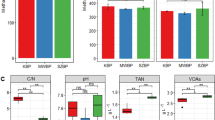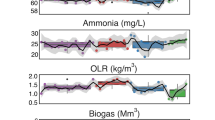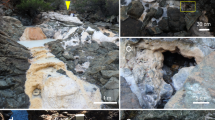Abstract
Microbial interactions have a key role in global geochemical cycles. Although we possess significant knowledge about the general biochemical processes occurring in microbial communities, we are often unable to decipher key functions of individual microorganisms within the environment in part owing to the inability to cultivate or study them in isolation. Here, we circumvent this shortcoming through the use of single-cell genome sequencing and a novel low-input metatranscriptomics protocol to reveal the intricate metabolic capabilities and microbial interactions of an alkane-degrading methanogenic community. This methanogenic consortium oxidizes saturated hydrocarbons under anoxic conditions through a thus-far-uncharacterized biochemical process. The genome sequence of a dominant bacterial member of this community, belonging to the genus Smithella, was sequenced and served as the basis for subsequent analysis through metabolic reconstruction. Metatranscriptomic data generated from less than 500 pg of mRNA highlighted metabolically active genes during anaerobic alkane oxidation in comparison with growth on fatty acids. These data sets suggest that Smithella is not activating hexadecane by fumarate addition. Differential expression assisted in the identification of hypothetical proteins with no known homology that may be involved in hexadecane activation. Additionally, the combination of 16S rDNA sequence and metatranscriptomic data enabled the study of other prevalent organisms within the consortium and their interactions with Smithella, thus yielding a comprehensive characterization of individual constituents at the genome scale during methanogenic alkane oxidation.
Similar content being viewed by others
Log in or create a free account to read this content
Gain free access to this article, as well as selected content from this journal and more on nature.com
or
Accession codes
References
Aeckersberg F, Bak F, Widdel F . (1991). Anaerobic oxidation of saturated hydrocarbons to CO2 by a new type of sulfate-reducing bacterium. Arch Microbiol 156: 5–14.
Aitken CM, Jones DM, Maguire MJ, Gray ND, Sherry A, Bowler BFJ et al (2013). Evidence that crude oil alkane activation proceeds by different mechanisms under sulfate-reducing and methanogenic conditions. GeochimCosmochim Acta 109: 162–174.
Albertsen M, Hugenholtz P, Skarshewski A, Nielsen KL, Tyson GW, Nielsen PH . (2013). Genome sequences of rare, uncultured bacteria obtained by differential coverage binning of multiple metagenomes. Nat Biotechnol 31: 533–538.
Anders S, Huber W . (2010). Differential expression analysis for sequence count data. Genome Biol 11: R106.
Aziz R, Bartels D, Best A, DeJongh M, Disz T, Edwards R et al (2008). The RAST Server: rapid annotations using subsystems technology. BMC Genomics 9: 75.
Breuil C, Kushner DJ . (1980). Effects of lipids, fatty acids, and other detergents on bacterial utilization of hexadecane. Can J Microbiol 26: 223–231.
Callaghan AV, Morris BEL, Pereira IAC, McInerney MJ, Austin RN, Groves JT et al (2012). The genome sequence of Desulfatibacillum alkenivorans AK-01: a blueprint for anaerobic alkane oxidation. Environ Microbiol 14: 101–113.
Chatterji S, Yamazaki I, Bai Z, Eisen J . (2008). CompostBin: A DNA composition-based algorithm for binning environmental shotgun reads. in: Vingron M, Wong L (eds) Research in Computational Molecular Biology. Springer: Berlin Heidelberg, Germany, pp 17–28.
Cheng L, Ding C, Li Q, He Q, Dai L-r Zhang H . (2013). DNA-SIP reveals that Syntrophaceae play an important role in methanogenic hexadecane degradation. PLoS One 8: e66784.
Dereeper A, Guignon V, Blanc G, Audic S, Buffet S, Chevenet F et al (2008). Phylogeny.fr: robust phylogenetic analysis for the non-specialist. Nucleic Acids Res 36: W465–W469.
Dick GJ, Andersson AF, Baker BJ, Simmons SL, Thomas BC, Yelton AP et al (2009). Community-wide analysis of microbial genome sequence signatures. Genome Biol 10: R85.
Gieg LM, Duncan KE, Suflita JM . (2008). Bioenergy production via microbial conversion of residual oil to natural gas. Appl Environ Microbiol 74: 3022–3029.
Grabherr MG, Haas BJ, Yassour M, Levin JZ, Thompson DA, Amit I et al (2011). Full-length transcriptome assembly from RNA-seq data without a reference genome. Nat Biotechnol 29: 644–652.
Grabowski A, Nercessian O, Fayolle F, Blanchet D, Jeanthon C . (2005). Microbial diversity in production waters of a low-temperature biodegraded oil reservoir. FEMS Microbiol Ecol 54: 427–443.
Gray ND, Sherry A, Grant RJ, Rowan AK, Hubert CRJ, Callbeck CM et al (2011). The quantitative significance of Syntrophaceae and syntrophic partnerships in methanogenic degradation of crude oil alkanes. Environ Microbiol 13: 2957–2975.
Henry CS, DeJongh M, Best AA, Frybarger PM, Linsay B, Stevens RL . (2010). High-throughput generation, optimization and analysis of genome-scale metabolic models. Nat Biotechnol 28: 977–982.
Holm L, Sander C . (1997). An evolutionary treasure: unification of a broad set of amidohydrolases related to urease. Proteins 28: 72–82.
Jones DM, Head IM, Gray ND, Adams JJ, Rowan AK, Aitken CM et al (2008). Crude-oil biodegradation via methanogenesis in subsurface petroleum reservoirs. Nature 451: 176–180.
Langmead B, Trapnell C, Pop M, Salzberg S . (2009). Ultrafast and memory-efficient alignment of short DNA sequences to the human genome. Genome Biol 10: R25.
Liu T, Wang F, Guo L, Li X, Yang X, Lin A . (2012). Biodegradation of n-hexadecane by bacterial strains B1 and B2 isolated from petroleum-contaminated soil. Sci China Chem 55: 1968–1975.
Liu Y, Balkwill DL, Aldrich HC, Drake GR, Boone DR . (1999). Characterization of the anaerobic propionate-degrading syntrophs Smithella propionica gen. nov., sp. nov. and Syntrophobacter wolinii. Int J Syst Bacteriol 49: 545–556.
Maestrojuán GM, Boone DR, Xun L, Mah RA, Zhang L . (1990). Transfer of Methanogenium bourgense, Methanogenium marisnigri, Methanogenium olentangyi, and Methanogenium thermophilicum to the genus Methanoculleus gen. nov., emendation of Methanoculleus marisnigri and Methanogenium, and description of new strains of Methanoculleus bourgense and Methanoculleus marisnigri. Int J Syst Bacteriol 40: 117–122.
McInerney MJ, Rohlin L, Mouttaki H, Kim U, Krupp RS, Rios-Hernandez L et al (2007). The genome of Syntrophus aciditrophicus: life at the thermodynamic limit of microbial growth. Proc Nat Acad Sci USA 104: 7600–7605.
Morita M, Malvankar NS, Franks AE, Summers ZM, Giloteaux L, Rotaru AE et al (2011). Potential for direct interspecies electron transfer in methanogenic wastewater digester aggregates. MBio 2: e00159–e00111.
Movahedi NS, Forouzmand E, Chitsaz H . (2012). De novo co-assembly of bacterial genomes from multiple single cells. 2012 IEEE International Conference on Bioinformatics and Biomedicine (BIBM), 1–5.
Okugawa S, Moayeri M, Pomerantsev AP, Sastalla I, Crown D, Gupta PK et al (2012). Lipoprotein biosynthesis by prolipoprotein diacylglyceryl transferase is required for efficient spore germination and full virulence of Bacillus anthracis. Mol Microbiol 83: 96–109.
Parkhomchuk D, Borodina T, Amstislavskiy V, Banaru M, Hallen L, Krobitsch S et al (2009). Transcriptome analysis by strand-specific sequencing of complementary DNA. Nucleic Acids Res 37: e123.
Rojo F . (2009). Degradation of alkanes by bacteria. Environ Microbiol 11: 2477–2490.
Rotaru A-E, Shrestha P, Liu F, Shrestha M, Markovaite B, Shrestha D et al (2013). Elucidating electrical connections for direct interspecies electron transfer in defined syntrophic methanogenic co-cultures. Final Program American Society for Microbiology 113th General Meeting P 143.
Scherr KE, Lundaa T, Klose V, Bochmann G, Loibner AP . (2012). Changes in bacterial communities from anaerobic digesters during petroleum hydrocarbon degradation. J Biotechnol 157: 564–572.
Seth-Smith HMB, Harris SR, Skilton RJ, Radebe FM, Golparian D, Shipitsyna E et al (2013). Whole-genome sequences of Chlamydia trachomatis directly from clinical samples without culture. Genome Res 5: 855–866.
Siddique T, Penner T, Semple K, Foght JM . (2011). Anaerobic biodegradation of longer-chain n-alkanes coupled to methane production in oil sands tailings. Environ Sci Technol 45: 5892–5899.
Shrestha PM, Rotaru AE, Summers ZM, Shrestha M, Liu F, Lovley DR . (2013). Transcriptomic and genetic analysis of direct interspecies electron transfer. Appl Environ Microbiol 79: 2397–2404.
Smith KS, Ingram-Smith C . (2007). Methanosaeta, the forgotten methanogen? Trends Microbiol 15: 150–155.
So CM, Phelps CD, Young LY . (2003). Anaerobic transformation of alkanes to fatty acids by a sulfate-reducing bacterium, strain Hxd3. Appl Environ Microbiol 69: 3892–3900.
Swan BK, Martinez-Garcia M, Preston CM, Sczyrba A, Woyke T, Lamy D et al (2011). Potential for chemolithoautotrophy among ubiquitous bacteria lineages in the dark ocean. Science 333: 1296–1300.
Trapnell C, Williams BA, Pertea G, Mortazavi A, Kwan G, van Baren MJ et al (2010). Transcript assembly and quantification by RNA-Seq reveals unannotated transcripts and isoform switching during cell differentiation. Nat Biotechnol 28: 511–515.
Tzintzun-Camacho O, Loera O, Ramírez-Saad HC, Gutiérrez-Rojas M . (2012). Comparison of mechanisms of hexadecane uptake among pure and mixed cultures derived from a bacterial consortium. Int Biodeterioration Biodegrad 70: 1–7.
Wang L-Y, Gao C-X, Mbadinga SM, Zhou L, Liu J-F, Gu J-D et al (2011). Characterization of an alkane-degrading methanogenic enrichment culture from production water of an oil reservoir after 274 days of incubation. Int Biodeterioration Biodegrad 65: 444–450.
Wang Z, Gerstein M, Snyder M . (2009). RNA-Seq: a revolutionary tool for transcriptomics. Nat Rev Genet 10: 57–63.
Wilkes H, Rabus R, Fischer T, Armstroff A, Behrends A, Widdel F . (2002). Anaerobic degradation of n-hexane in a denitrifying bacterium: Further degradation of the initial intermediate (1-methylpentyl)succinate via C-skeleton rearrangement. Arch Microbiol 177: 235–243.
Yoon HS, Price DC, Stepanauskas R, Rajah VD, Sieracki ME, Wilson WH et al (2011). Single-cell genomics reveals organismal interactions in uncultivated marine protists. Science 332: 714–717.
Zedelius J, Rabus R, Grundmann O, Werner I, Brodkorb D, Schreiber F et al (2011). Alkane degradation under anoxic conditions by a nitrate-reducing bacterium with possible involvement of the electron acceptor in substrate activation. Environ Microbiol Rep 3: 125–135.
Zellner G, Stackebrandt E, Messner P, Tindall B, De Macario EC, Kneifel H et al (1989). Methanocorpusculaceae fam. nov., represented by Methanocorpusculum parvum, Methanocorpusculum sinense spec. nov. and Methanocorpusculum bavaricum spec. nov. Arch Microbiol 151: 381–390.
Zengler K, Richnow HH, Rossello-Mora R, Michaelis W, Widdel F . (1999). Methane formation from long-chain alkanes by anaerobic microorganisms. Nature 401: 266–269.
Zengler K, Palsson BO . (2012). A road map for the development of community systems (CoSy) biology. Nat Rev Micro 10: 366–372.
Acknowledgements
We thank Rohini Patel for technical assistance and Ramunas Stepanauskas (Bigelow Laboratory for Ocean Sciences) for assistance with single-cell genome amplification. We also thank Pravin Shrestha and Derek Lovley (UMass, Amherst) for supplying total RNA of the Geobacter consortium. This work was supported by the Office of Science (BER), U.S. Department of Energy, award no. DE-SC0004485 and DE-SC0004917. This Whole-Genome Shotgun project has been deposited at DDBJ/EMBL/GenBank under the accession AWGX00000000. The version described in this paper is version AWGX01000000. Metatranscriptome analysis can be accessed through GEO, accession no. GSE49830.
Author information
Authors and Affiliations
Corresponding author
Ethics declarations
Competing interests
The authors declare no conflict of interest.
Additional information
Supplementary Information accompanies this paper on The ISME Journal website
Supplementary information
Rights and permissions
About this article
Cite this article
Embree, M., Nagarajan, H., Movahedi, N. et al. Single-cell genome and metatranscriptome sequencing reveal metabolic interactions of an alkane-degrading methanogenic community. ISME J 8, 757–767 (2014). https://doi.org/10.1038/ismej.2013.187
Received:
Revised:
Accepted:
Published:
Issue date:
DOI: https://doi.org/10.1038/ismej.2013.187
Keywords
This article is cited by
-
MiDAS 5: Global diversity of bacteria and archaea in anaerobic digesters
Nature Communications (2024)
-
Implementation of Genetic Engineering and Novel Omics Approaches to Enhance Bioremediation: A Focused Review
Bulletin of Environmental Contamination and Toxicology (2022)
-
Metabolic cooperation and spatiotemporal niche partitioning in a kefir microbial community
Nature Microbiology (2021)
-
Identity and hydrocarbon degradation activity of enriched microorganisms from natural oil and asphalt seeps in the Kurdistan Region of Iraq (KRI)
Biodegradation (2021)
-
Bacterial and archaeal diversity in oil fields and reservoirs and their potential role in hydrocarbon recovery and bioprospecting
Environmental Science and Pollution Research (2021)



